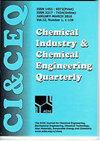青桃果实热风干燥及生物活性物质降解动力学研究
IF 0.8
4区 工程技术
Q4 CHEMISTRY, APPLIED
Chemical Industry & Chemical Engineering Quarterly
Pub Date : 2023-01-01
DOI:10.2298/ciceq220614011d
引用次数: 0
摘要
本研究的目的是为了确定干燥是否是一种合适的保存方法,并确定干燥过程结束时吉布鲁果(Viburnum opulus L.)生物活性成分的变化。在本研究中,在不同的温度(50、60和70℃)下,在柜式干燥机中干燥吉拉布果。采用高效液相色谱法测定反式白藜芦醇、水溶性维生素、有机酸和酚类化合物含量,分光光度法测定总酚含量和抗氧化活性。由于在50,60和70?在70℃时,组分损失最大。经70℃干燥处理后,总酚类物质和抗氧化能力含量分别损失73.64%和84.08%。鲜果中反式白藜芦醇含量为1.26±0.05 (g/100 g干重),在50、60和70℃干燥后,其含量分别降至0.31±0.03、0.30±0.01和0.21±0.01。C,分别。就维生素而言,烟酸的损失最大。经70℃干燥处理后,鲜吉鲁果的抗坏血酸、吡哆醇、烟酸和硫胺素含量分别从0.78、3.14、0.12和0.30 g/100 g下降到0.24、0.75、0和0.14 g/100 g。此外,还建立了水溶性维生素、总酚含量、抗氧化活性和反式白藜芦醇的干燥动力学模型。Page模型最好地描述了果实在70℃时的干燥行为。C和抛物线模型都是50?C和60?水溶性维生素、总酚含量、抗氧化活性和反式白藜芦醇的热降解符合一级动力学模型。本文章由计算机程序翻译,如有差异,请以英文原文为准。
Hot-air drying and degradation kinetics of bioactive compounds of gilaburu (Viburnum opulus L.) fruit
The purpose of this study is to determine whether drying is a suitable preservation method for gilaburu fruit and to determine the changes in the bioactive components of gilaburu fruit (Viburnum opulus L.) at the end of the drying process. In this study, gilaburu fruits were dried in cabinet dryer at different temperatures (50,60 and 70?C). The analyses of trans-resveratrol, water-soluble vitamins, organic acids and phenolic compounds were made by using the HPLC method while total phenolic contents and antioxidant activity were spectrophotometric. As a result of drying of gilaburu fruit at 50, 60 and 70?C, the highest component loss was observed at 70?C. A loss of 73.64% and 84.08%, respectively, was detected in the total phenolic substance and antioxidant capacity content of gilaburu fruit after drying at 70?C. While the trans-resveratrol content was 1.26?0.05 (g/100 g dry weight (DW)) in fresh fruit, it reduced to 0.31?0.03, 0.30?0.01 and 0.21?0.01 after drying at 50, 60 and 70?C, respectively. In terms of vitamins, the highest loss was seen in niacin. The contents of ascorbic acid, pyridoxine, niacin and thiamine contents of fresh gilaburu fruit decreased from 0.78, 3.14, 0.12 and 0.30 g/100 g to 0.24, 0.75, 0 and 0.14 g/100 g, respectively, after drying at 70?C. In addition, drying kinetics of water-soluble vitamins, total phenolic contents, antioxidant activity and trans-resveratrol were modeled. The Page model best described the drying behavior of fruits at 70?C, and the Parabolic model at both 50?C and 60?. Thermal degradation of water-soluble vitamins, total phenolic contents, antioxidant activity and trans-resveratrol were fitted the first-order kinetic model.
求助全文
通过发布文献求助,成功后即可免费获取论文全文。
去求助
来源期刊

Chemical Industry & Chemical Engineering Quarterly
CHEMISTRY, APPLIED-ENGINEERING, CHEMICAL
CiteScore
2.10
自引率
0.00%
发文量
24
审稿时长
3.3 months
期刊介绍:
The Journal invites contributions to the following two main areas:
• Applied Chemistry dealing with the application of basic chemical sciences to industry
• Chemical Engineering dealing with the chemical and biochemical conversion of raw materials into different products as well as the design and operation of plants and equipment.
The Journal welcomes contributions focused on:
Chemical and Biochemical Engineering [...]
Process Systems Engineering[...]
Environmental Chemical and Process Engineering[...]
Materials Synthesis and Processing[...]
Food and Bioproducts Processing[...]
Process Technology[...]
 求助内容:
求助内容: 应助结果提醒方式:
应助结果提醒方式:


